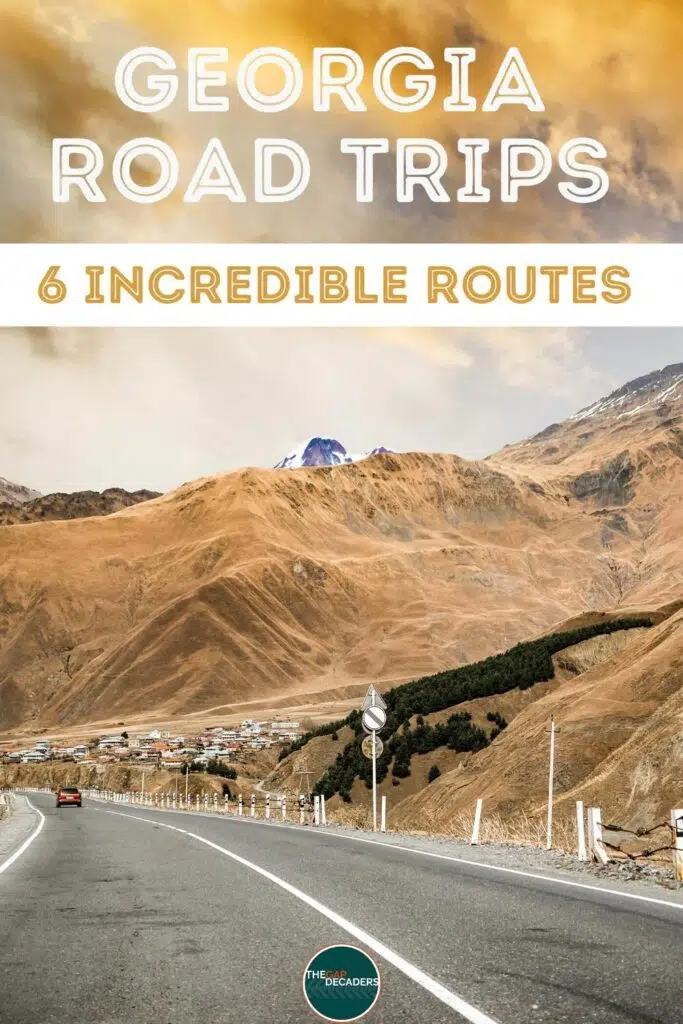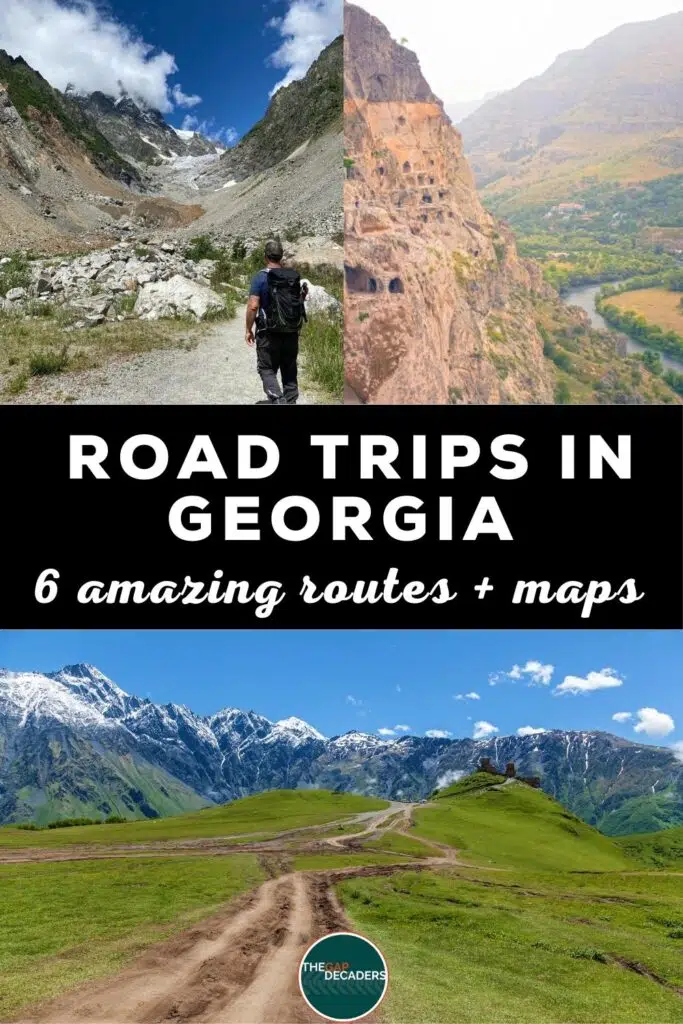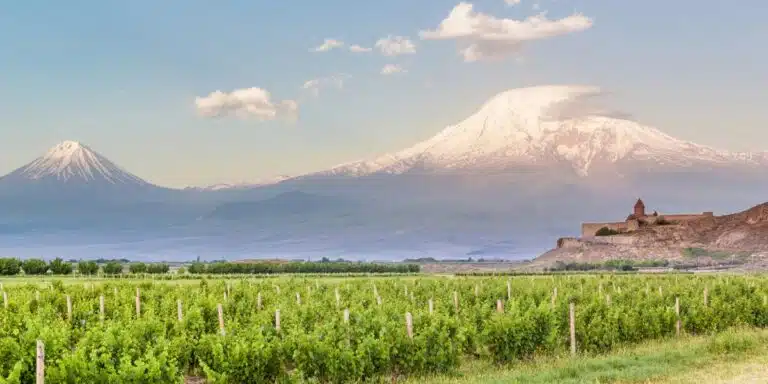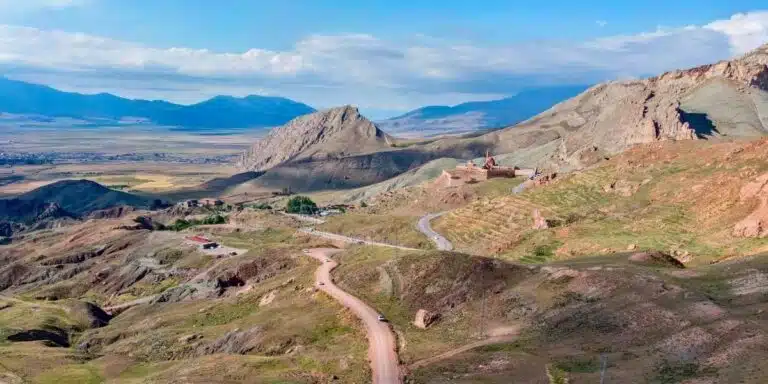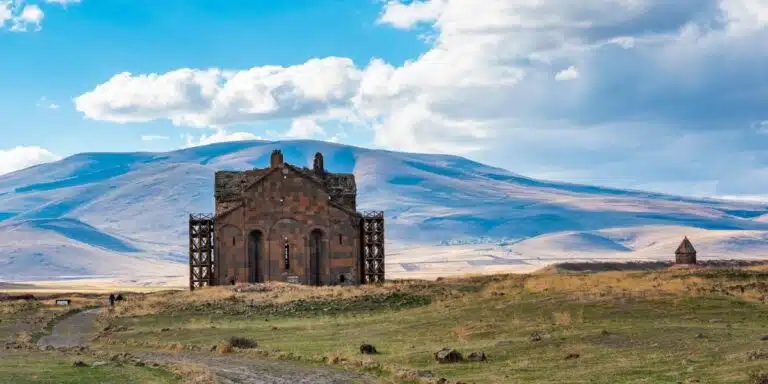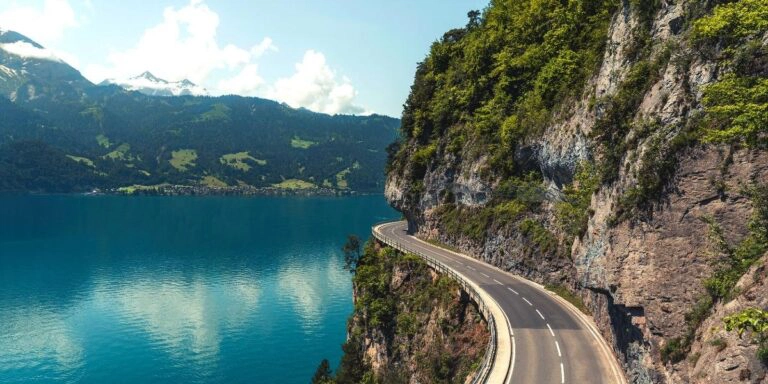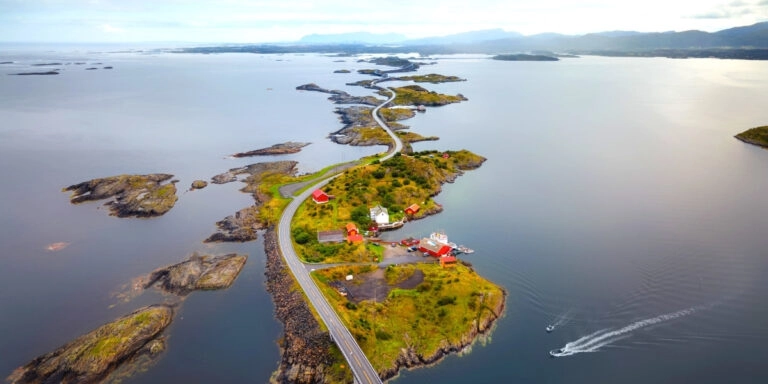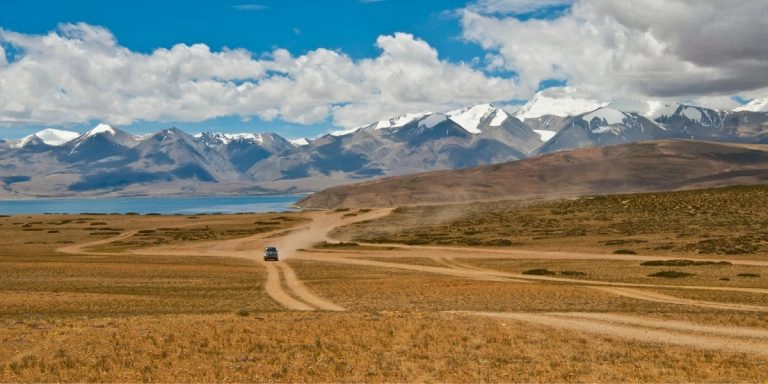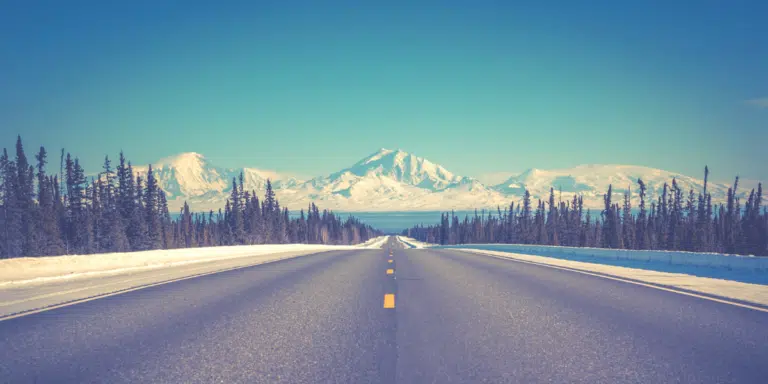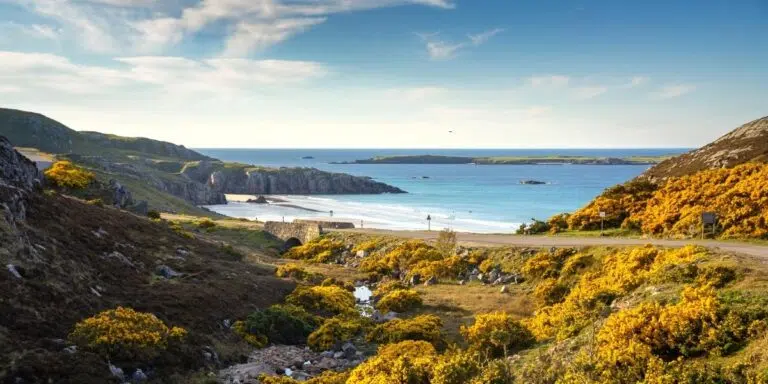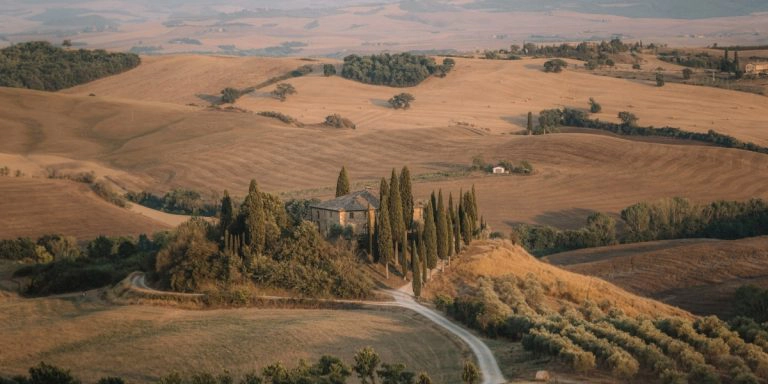This post may contain affiliate links, from which we earn an income. Click here to read our affiliate policy.
Georgia is undoubtedly one of the best road trip countries in Europe, with all four corners of this tiny nation offering diverse experiences, surrounded by the glorious backdrop of dramatic mountains, beautiful coasts and rolling steppe.
A Georgia road trip rewards you with Top Gear style driving, tracks that traverse mountain ranges, miles of empty tarmac across rolling pasture land and iconic roads famous for the ‘dangerous’ driving experience. What better way to explore Georgia?
We spent three months road tripping around Georgia in 2022, and in this Georgia country road trip guide we’ll share the best Georgia road trip ideas, with suggestions about what to see and do on the way, and travel tips to help you plan your perfect trip.
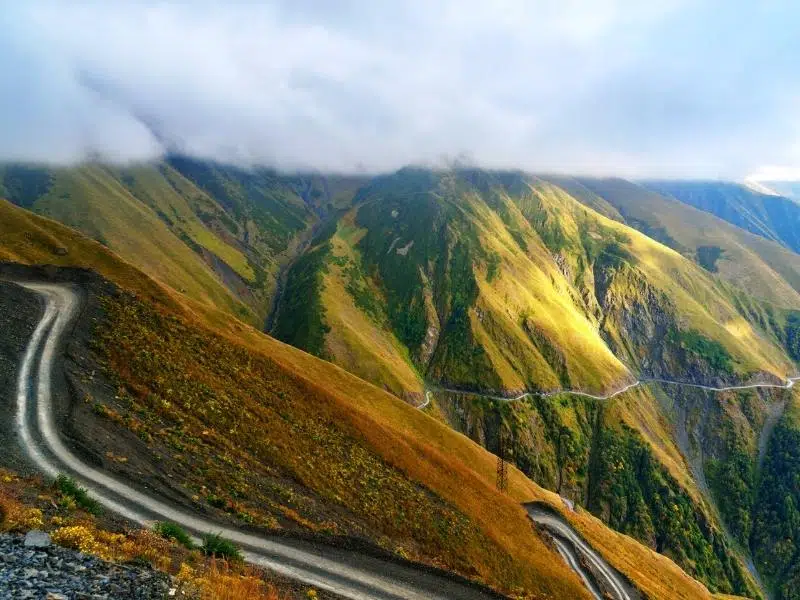
Getting There
Fly into Tbilisi Airport, centrally located in Georgia and perfectly located for all of our Georgian road trip itineraries. We recommend booking through Skyscanner for live deals and the best prices.
Are you planning to rent a car in Georgia? We recommend hiring your car with Localrent.com, an aggregator of local car rental companies. They work with small car rental companies that only operate in their location and closely monitor the quality of their service. This means you get the best service for the lowest price.
For a real adventure, hire a campervan in Georgia. Overlando offer self-drive campervan trips with their fully equipped 4×4 campers, including the awesome (and very cute) UAZ Bukhanka, a Soviet classic named after a loaf of bread!
If you prefer a smaller vehicle, check out their Lada and Hilux cars with rooftop tents. You can park and sleep anywhere in Georgia, as long as you’re not on private land. Use the Park4Night app to find overnight spots, and sleep on a high mountain pass, next to a beautiful river or hot spring, or in a wildflower meadow.
Best Time for a Georgian Road Trip
Spring
Spring is a wonderful time to road trip Georgia, as the winter gives way to warmer weather and the countryside comes alive with wildflowers and baby animals… in the lowlands that is! There will still be snow on roads into the Caucasus mountains, and some roads will remain closed.
Late April and May is a great time to visit the area around Kutaisi, and explore Davit Gareja, Vardzia and Vashlovani, although the latter is best explored in the dry when the clay-like mud tracks are passable.
Summer
July and August are the busiest months in Georgia, especially around Tbilisi, Kutaisi and Batumi. This means flights, accommodation and car hire will be more expensive, and attractions will be busier.
But when the sun shines, the roads to the Higher Caucasus open, and Tusheti and Mestia become go-to destinations, as the final snows melt and the roads become passable once again. Summer is also the best time for outdoor adventures like hiking, paragliding, quad bike trekking and rafting.
Autumn
Autumn is a gorgeous time in Georgia, which has its share of vibrant autumnal colours to enjoy, whilst the warmth of the summer remains into early October. It’s also the best time to explore Kakheti when the grape harvest takes place and you can learn about how traditional Georgian wine is made.
Winter
Much of Georgia sees snow and rain in winter, which causes damage to roads. Landslides, rock falls and disintegrating surfaces are not uncommon, even in the low plains and steppe, and some roads shut completely.
But, the landscape will be stunning and in the lowlands, you’ll still be able to visit all the attractions, as long as you wrap up warm!
Is this your first time visiting Georgia? Get all the information you need in our Georgia Travel Guide, including what to pack, the best time of year to go, getting there and practical tips to help you have the best trip!
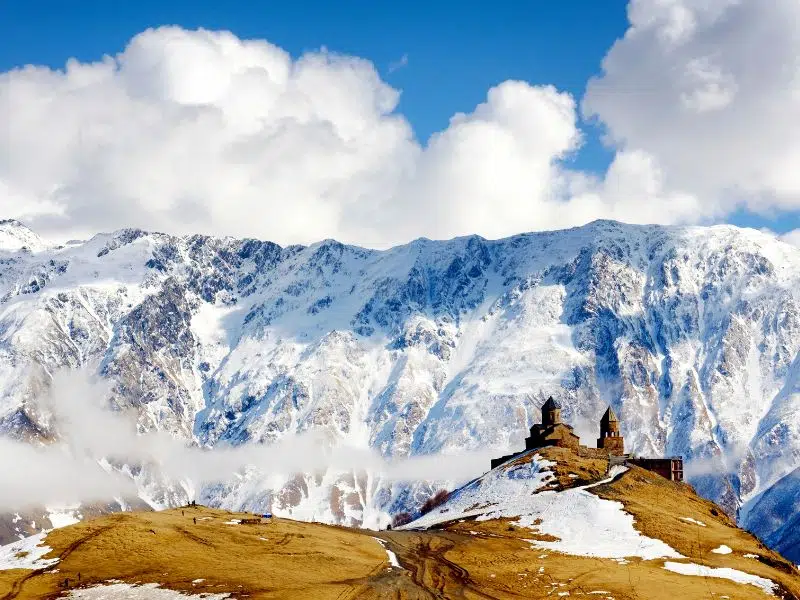
Georgian Military Highway
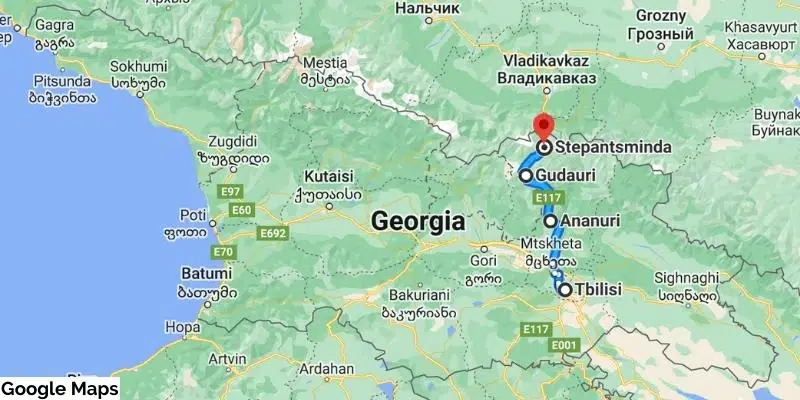
Overview
One of the most iconic road trips in Georgia, this ancient passage to Russia from Tbilisi is a real adventure and the route north is both spectacular and challenging.
The road leaves the capital city of Tbilisi and slowly winds its way into the Greater Caucasus Range, following a millennia-old route used by traders through the ages. The road has existed since before the 1st century BCE, and in an incredible feat of man against nature, it was converted into a proper carriage road in 1783.
Drive the Georgian Military Road and you’ll be rewarded with several of Georgia’s must-see attractions en route, and be able to enjoy the kudos that comes with driving what is considered one of the world’s most dangerous roads.
RELATED POST: SIM Cards in Georgia: How to Buy + Best Deals
Highlights
Mtskheta
Mtskheta is one of the oldest and most spiritual cities in Georgia, and to this day remains the headquarters of the Georgian Orthodox Church.
A charming town at the confluence of the Mtkvari and Aragvi rivers, Mtskheta is picturesque and the ancient churches and monasteries are recognised as a UNESCO World Heritage site due to their historical importance.
Must-sees are the Jvari Monastery which sits high on a hill overlooking the town, the Samtavro Monastery and the Svetitskhoveli Cathedral.
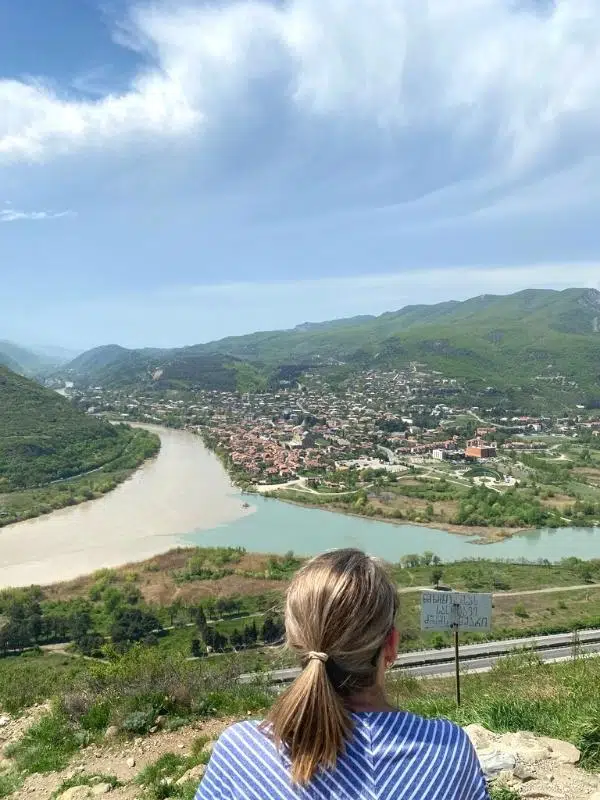
Ananuri Fortress Complex
Stop on the way to see the 17th-century Ananuri Fortress which sits high above the shining turquoise Zhinvali reservoir. This historic site, which typifies Georgia, includes a fortress, the Church of the Mother of God, the Church of the Deity, Mkurnali Church and a bell tower.
Just before the roadside parking (which you have to pay for) is a road which leads down to Zhinvali lake, and a newly created park and picnic area. There is free parking, a few cafés, boats for rent and picnic tables, making it a great rest stop.
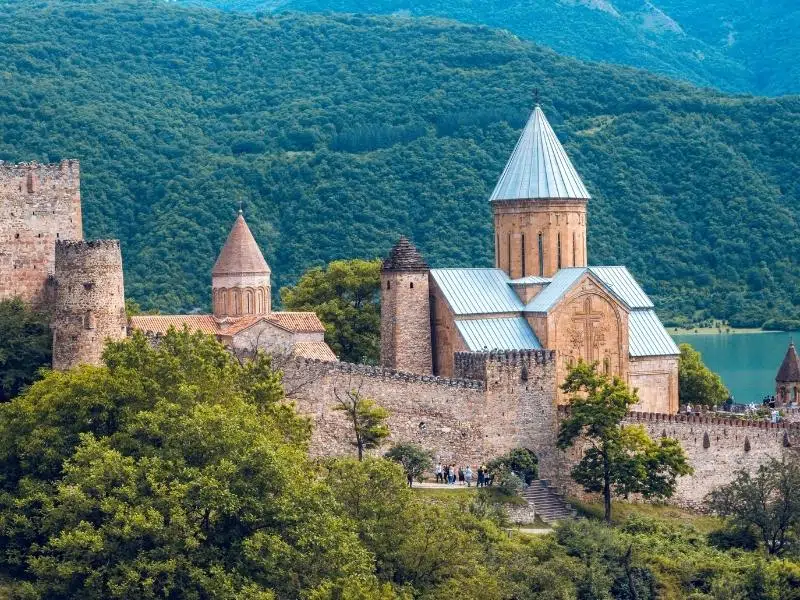
Gudauri
Georgia’s premier ski resort sits 2,192m above sea level and becomes a mountain playground in summer. You can go paragliding, horse riding and mountain biking, take out a quad bike and ride the cable car to Kobi and the Truso gorge, as well as hit the hiking trails around the local area.
Gudauri is a great place to base yourself for a few nights if you’re looking to extend this road trip beyond two days.
Russia Georgia Friendship Monument
Between Gudauri and the Jvari Pass is the Russian Friendship Monument. This concrete behemoth was built in 1983 to celebrate the bicentennial of the Treaty of Georgievsk and the ongoing friendship between Soviet Georgia and Soviet Russia, which is ironic when you realise that just a few miles west is the border of the breakaway region of South Ossetia, annexed in 2008 and controlled by Russia.
The monument itself is a huge round stone and concrete structure overlooking the breathtaking Devil’s Valley. Inside the monument is a large and colorful tile mural that spans the whole circumference of the structure and depicts scenes of Georgian and Russian history.
There are also spectacular views from the monument along the gorge, with the snaking silver Aragvi river at the bottom.
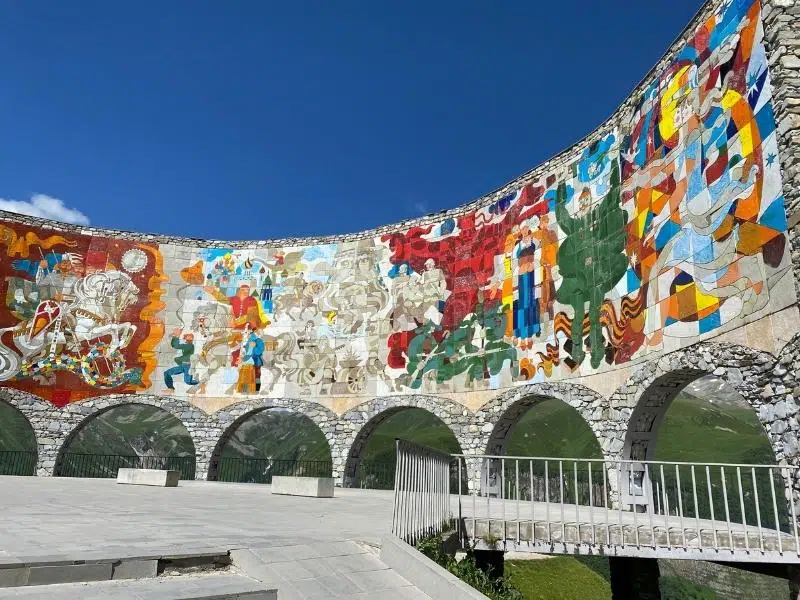
Jvari Pass
The Georgian Military Roads tops out at 2,395m above sea level at the Jvari Pass, also known as Krestovy Pereval or Cross Pass. At the top of the pass are stopping places where you can go for a horse ride into the mountains drink tea and chacha (Georgian pomace brandy) or get something to eat as you enjoy the surroundings.
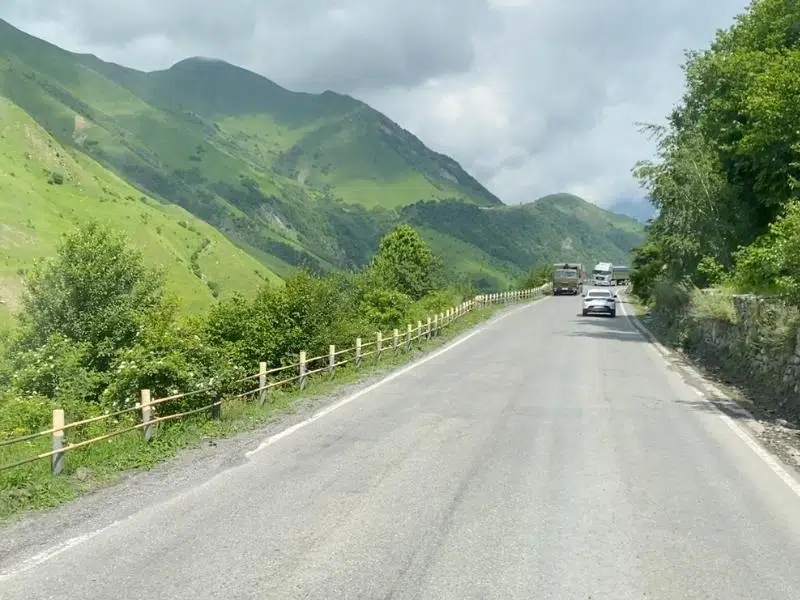
Travertine Mineral Springs
Hugging the road is a curious natural phenomenon formed by the deposits of sulphur mineral springs, which leave behind limestone formations, known as travertine. Water still flows down the travertines which are part of the Kazbegi Protected Areas.
It can be hard to stop here as parking is very limited, and it’s on a bend in the road. If you can’t manage it going one way, try on the return!
Kazbegi
Kazbegi (its Soviet name) also called Stepantsminda (its official name), is the last town before the Russian border. At the foot of the 5,054m Mount Kazbek, the town is a popular stop on the route north.
The Gergeti Trinity Church is the town’s poster child, and deservedly so. A fairly unremarkable and typical Georgian church, it’s the location that adds the wow factor. Surrounded by the vast mountains of the Greater Caucasus, the church itself sits on a high plateau above the town, and is a photographer’s dream.
Kazbegi makes the perfect base to explore the local area, and hikers will especially enjoy the Kazbeg Glacier and Gergeti Glacier. The homestays and guesthouses offer a warm welcome, as well as delicious homemade Georgian food.
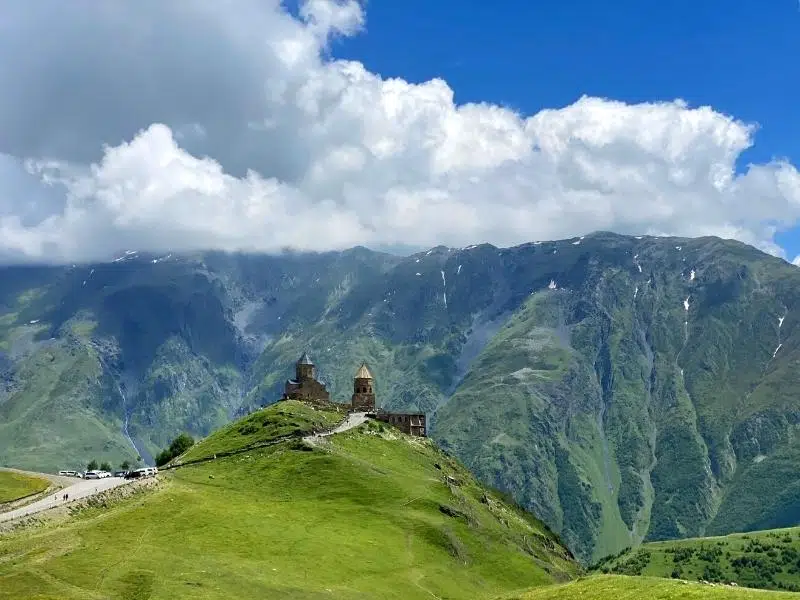
Dariali
The final few attractions before the Russian border, the 11km long Dariali gorge and the Dariali monastery complex are both worth a stop before you head south again.
Route & Travel Tips
The route is easy enough, but the changing road surfaces, frequent landslides and volume of freight traffic mean you need to be alert at all times, and for some people, this can detract from the drive and the surrounding spectacular scenery.
Although the actual drive time one way is just three hours (according to Google) we wouldn’t advise trying to do this trip in one day. The likelihood of you actually getting from Tbilisi to Kazbegi in three hours is pretty low – by the time you’ve stopped to see stuff, tackled the road and freight traffic, dodged the animals along the road, and slowed down for balconies and tunnels, it’s more likely to be six hours!
It is possible to drive the route year-round, and a lot of effort goes into keeping it open for freight between Georgia and Russia. However, heavy snow and avalanches may mean parts of the road are closed with little notice and it may become unpassable for days at a time, whilst emergency repairs are carried out. Always carry food, water and warm clothing if you drive this route in winter.
Although a brand new tarmac road was opened from Kazbegi up to the Gergeti Church in 2018, it is currently closed (2022) due to a ‘landslide’. It’s fairly common knowledge that there is no landslide and the road is in good condition, but it is more profitable for the local 4×4 taxi drivers to take visitors up at 70GEL a time on the old road, a bone-rattling drive over makeshift bridges and badly rutted roads. You just have to suck it up if you want to see the church and its incredible views.
Are you planning a trip to Georgia but nervous about driving there? If you’ve heard horror stories about the roads and drivers in Gerogia, then head across to our complete guide to driving in Georgia, for tips and info to boost your driving confidence and keep you safe on the road.
Batumi to Mestia
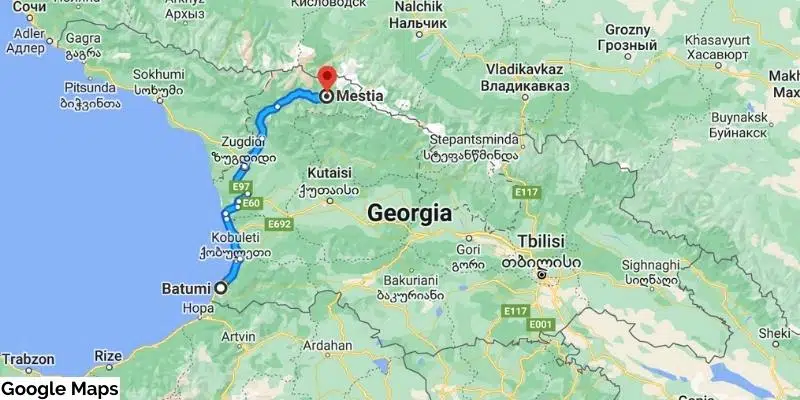
Overview
The journey from Batumi to Mestia is full of contrasts. From contemporary urban landscape to dramatic mountains and glaciers, this Georgia itinerary will take you from a modern city to a fascinating centuries-old stronghold.
The road to Mestia itself is legendary. Once you leave Zugdidi, you’ll start a love affair with this special route, which has to be one of the most scenic drives in Georgia. Expect plenty of twists and turns, rough cut tunnels, sheer drops and dramatic gorges as you follow this snaking road along the edge of the raging Patara Enguri river.
Highlights
Batumi
Batumi is a city like none other in Georgia. With Parisian-style tree-lined boulevards lined with belle epoque buildings and a Baku-style promenade lined with contemporary casinos, hotels and sculptures, Batumi is a world away from historic Georgia.
The Georgians head to Batumi to holiday and party, and its Black Sea location makes it a perfect stop for a few days. Walk the promenade and admire the modern styling, spend time exploring the wine bars and eclectic restaurants of the old town (Як вдома gets our vote for the best Ukrainian food in Georgia), and soak up Batumi’s unique vibe.
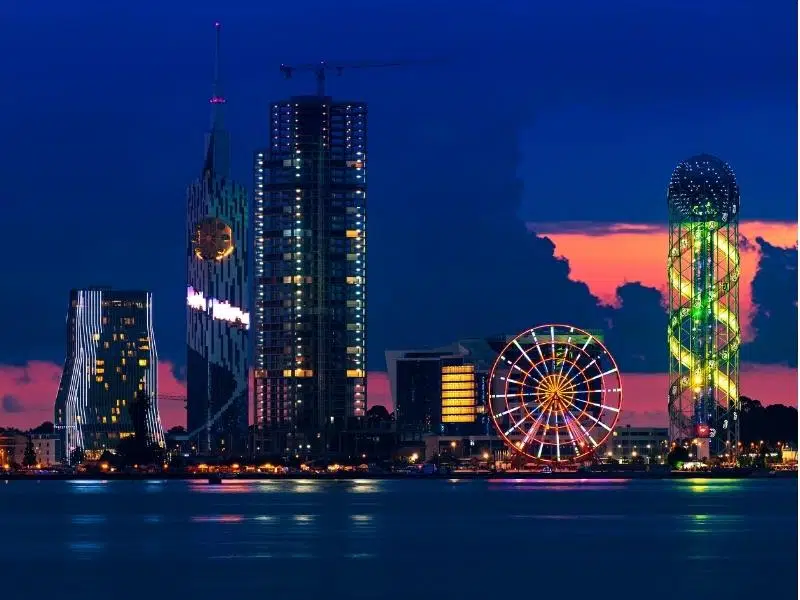
Zugdidi
Zugdidi is the capital of western Georgia’s Samegrelo-Zemo Svaneti region and is worth a stop as you head north.
Visit the Dadiani Palace, a fairytale castle and one-time home to the Dadiani dynasty, which ruled the region. The castle is home to a museum which showcases the history of the dynasty and has over 4,000 exhibits including rare items like a robe of the Virgin Mary, and a Napoleon I death mask.
Next to the palace are the Botanical Gardens, which are home to over eighty genera of exotic plants introduced from southeast Asia, India, Japan, the Mediterranean and the Americas.

Rukhi Fortress
A few miles north of Zugdidi and just off the Mestia road is the Rukhi castle, a tumbledown fortress built in the middle ages ad now covered in vines. From this strategic viewpoint, you can see across the border into Abkhazia, the breakaway region controlled by Russia.
Sisatura Ethno Village
Don’t miss this gem in the village of Chkhoria. The award-winning Sisatura Village is a little piece of authentic Samegrelo culture just waiting for you to explore.
Here you’ll find a living museum, housing artefacts preserved from history. Guests can try chokha, the traditional male dress of the Caucasus, take part in the preparation of local dishes, observe corn processing techniques passed down over generations, listen to live Megrelian folk music and meet local domestic animals.
Enguri Dam
The Enguri or Inguri Dam is a hydroelectric dam on the river of the same name and boasts being the world’s second-highest concrete arch dam, with a height of 271.5 metres. You’ll see the dam signed from the road, where there is a viewpoint which is perfect for taking photos of the impressive structure and the turquoise waters.
From the dam to Mestia, there are no real villages or attractions. But, you don’t need them when you’re surrounded by magnificent scenery at every turn. Make sure to check out the wooden bridge which crosses the river to Idliani, and the Dog’s Waterfall a little further on.
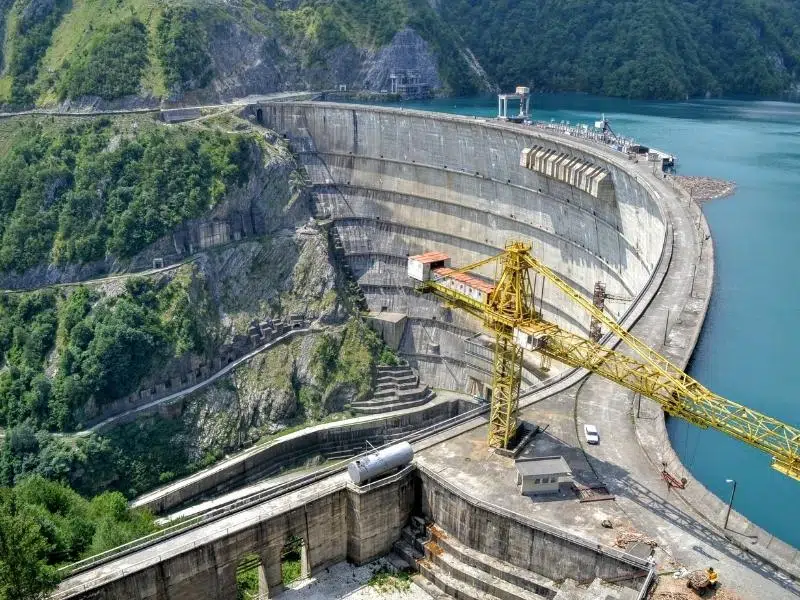
Mestia
You’ll know you are close to the Upper Svaneti townlet of Mestia when the road stops climbing and you start to traverse the highland mountains and pastures of the Zemo Svaneti National Park. The distinctive summit of Mount Ushba at 4,710m will slowly reveal itself and you’ll start to see the iconic Svan towers in the distance.
Mestia, known as ‘the country of a thousand towers’ is a mix of restaurants, cafés, small shops, homestays and hotels. It’s a busy little place, where cows still wander the streets, overlanders test their mettle and hikers set off on the local trails.
You’ll want a few days here at least, to hike to the gorgeous Koruldi Lakes and the Chalaadi Glacier, take the Hatsvali cable car and spend time learning about the region’s bloody history in the Svaneti Museum of History and Margiani’s House Museum, located in a Svan tower.
If you have time, you might even want to dare the drive to Ushguli, Europe’s highest village. The 46.5km road to Ushguli can be driven in summer, or you can get a taxi from town – make sure to stop and see the Tower of Love on the way.
RELATED POST: Mestia Georgia: Your Complete Travel Guide
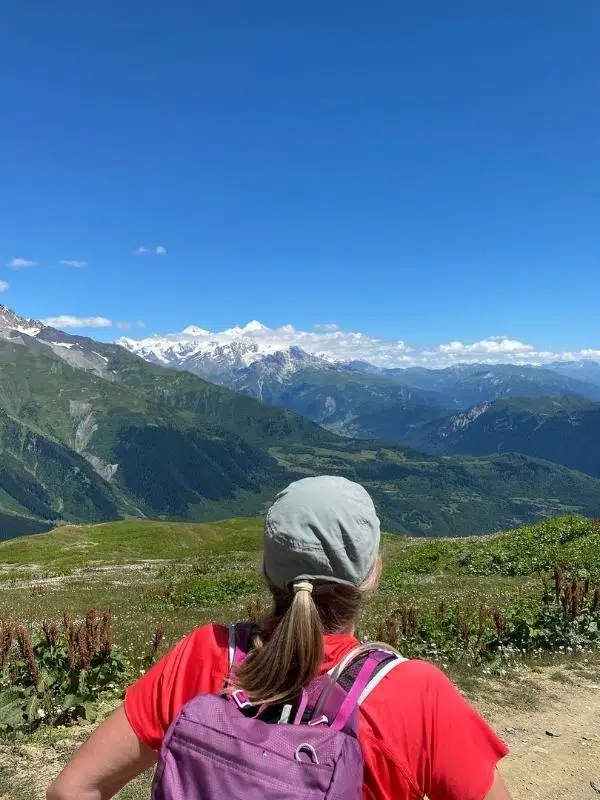
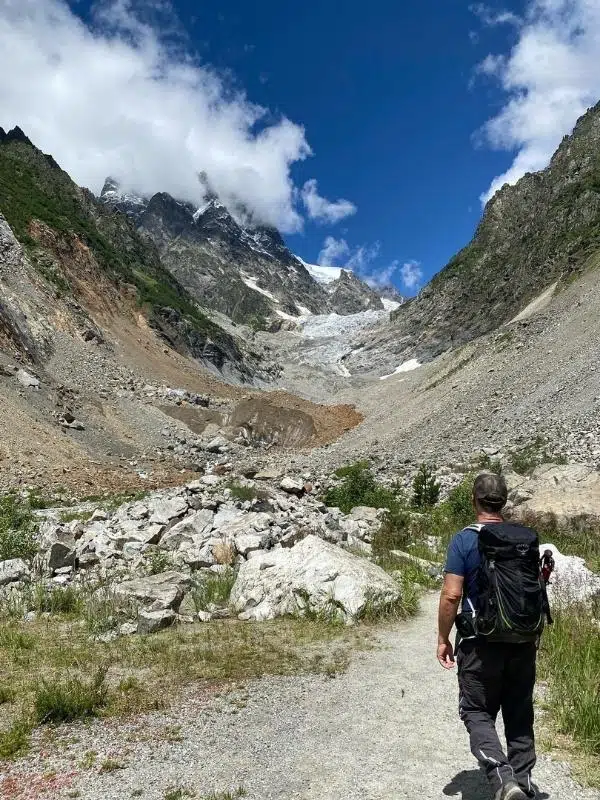
Route & Travel Tips
The road to Mestia from Zugdidi, known as the Zugdidi-Jvari-Mestia-Lasdili highway, is sealed but there will be places where the tarmac has been washed away, leaving gravel in its wake. Even in summer, parts of the road will be missing as the effects of winter take their toll and the road maintenance teams race to catch up with, and repair, damage.
Unlike the Georgian Military Road, the route to Mestia is quiet – we drove for long stretches without seeing another vehicle. Make sure you have a working mobile phone with you, and plenty of water and food should the worst happen. You may have to wait a while to be recovered if you break down!
Mestia is a popular ski destination in the winter, and the village remains busy. It is possible to drive there, and the road generally remains open. But, heavy snow, rock falls, icicle falls in the tunnels and slippery surfaces are not uncommon, so we would say don’t attempt this route in winter unless you are experienced at driving in this type of weather, are confident behind the wheel and have the right vehicle for the road with snow chains fitted.
If you’re planning on getting to Mestia from the east, via the Zagari Pass and Ushguli, you will need a 4WD vehicle and be able to attempt the road in good weather. This spectacular route is not for the faint-hearted.
We recommend contacting the Geo Road hotline on +995 322 31 30 76 to check road conditions before you depart.
Make sure you have travel insurance you can trust when visiting Georgia. We recommend True Traveller for their 5-star TrustPilot reviews, variety of cover options, best activities cover as standard, great prices and excellent service.
Kakheti Loop
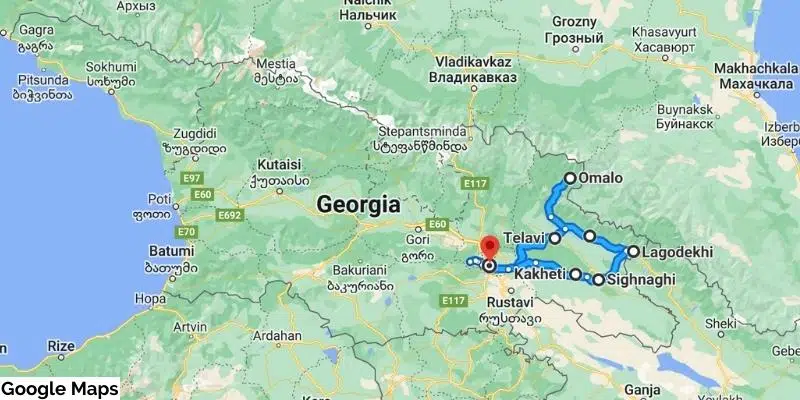
Overview
Famous for its wine, the Kakheti region is within easy reach of Tbilisi. It’s also home to the magnificent Tusheti National Park, and the Lagodekhi Protected Areas, where the mountainous landscapes are wild and raw.
As you wind your way along the Kakheti wine route through the peaceful Alazani Valley, studded with monasteries and wineries, you’ll be able to stop off at local marani (wine cellars) to sample the traditionally produced Georgian wine.
In the national parks, hiking is a must, with plenty of options for single-day, multi-day and long-distance hiking, and trekking with horses. In these high mountains, bears, leopard, golden eagle, bearded vultures, lynx and wolf still roam wild.
Highlights
Telavi
Set in the foothills of the Gombori Mountains with the Greater Caucasus always in view, Telavi is the charming capital of the Kakheti region.
As well as tasting the local wines and taking a wander around this atmospheric small city, you should also check out Batonis Castle, the colourful heritage homes with their intricate carved balconies on Erekle II and Cholokashvili Street, and go shopping for local ceramics, and wine of course!
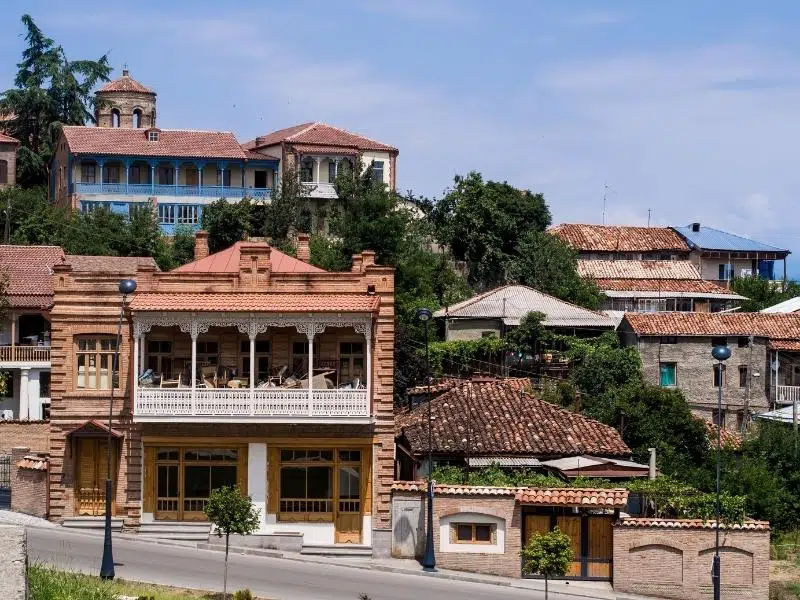
A Trio of Monasteries
The Georgians have a knack for building their monasteries in fantastic locations, and the triumvirate of Ikalto, Dzveli Shuamtad and Alaverdi is no exception. To the east of Telavi, you can see these three historic religious buildings in a day, and be in awe of the views as you drive between them.
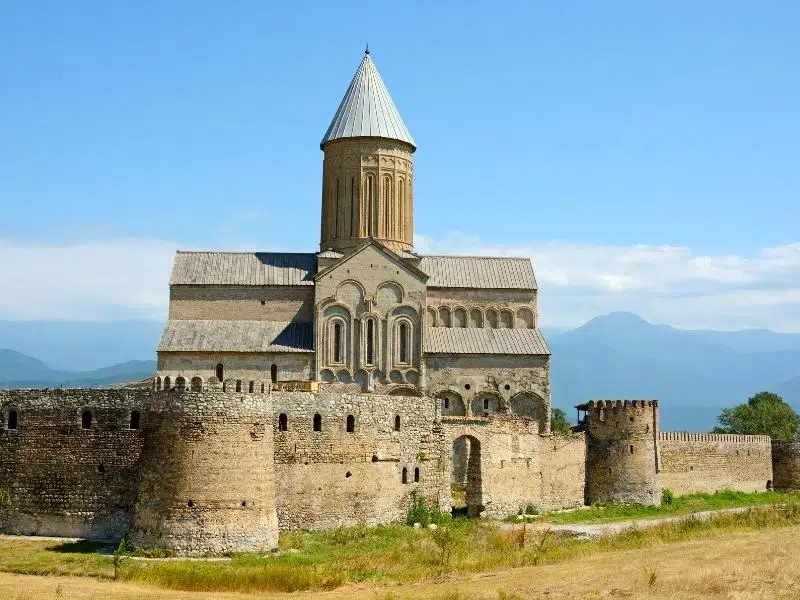
Tusheti National Park
Widely considered the most dangerous road in Georgia, if not the Caucasus, the Tusheti road from Pshavelli to Omalo is 70km of snaking switch-back track across the Abano Pass, which peaks at 2,826m. It will take five to six hours to drive it one way, and nerves of steel are required.
Once in Omalo, the capital of Tusheti, you can go hiking, explore the impressive Keselo Fortress above the town, check out the Tusheti towers in the region and visit the high mountain villages of Dartlo, Chesho, Parsma and Bochorna.
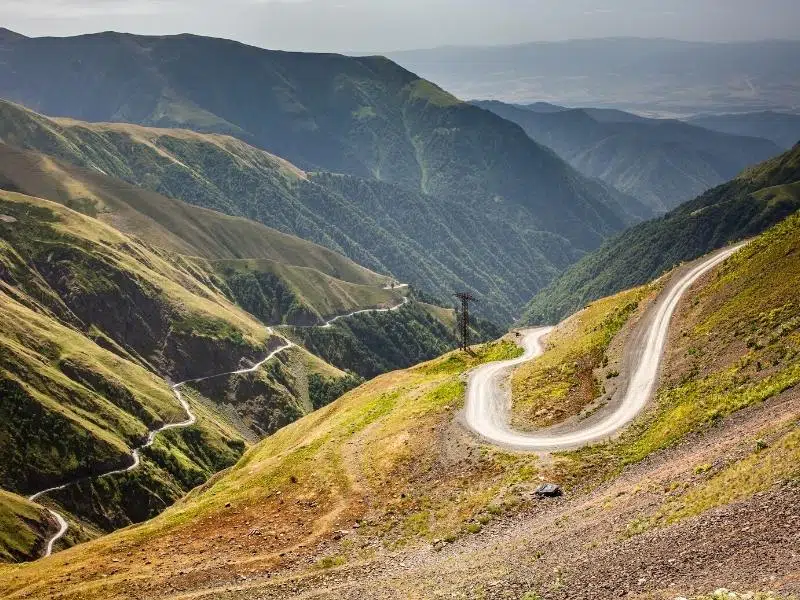
Wine Tours
Along the road from Pshavelli to Lagodekhi, sandwiched between the Greater Caucasus foothills and the Alazani river, are many wineries. Most offer tours and tastings, so you can find out about how Georgian wine is made and hopefully pick up a few bottles as you leave!
Traditional Georgian wine is made in qvevri, which are large earthenware vessels buried in the ground and used for fermentation, storage and ageing – this process is now UNESCO-listed. Viniculture here is a sacred part of family life, culture and folklore, and winemakers, both amateur and professional, take high pride in their craft.
We enjoyed a tour of the Kvareli wine cave, which features a tunnel cut into the rock of the mountains, which is 7.7km long! You can’t explore the whole tunnel, but it’s interesting to see more than 26,000 bottles of their best wines stored here.
In Kverali itself, we fell in love with the red semi-sweet Saperavi wines made at the Kindzmarauli winery, one of the oldest in the region.
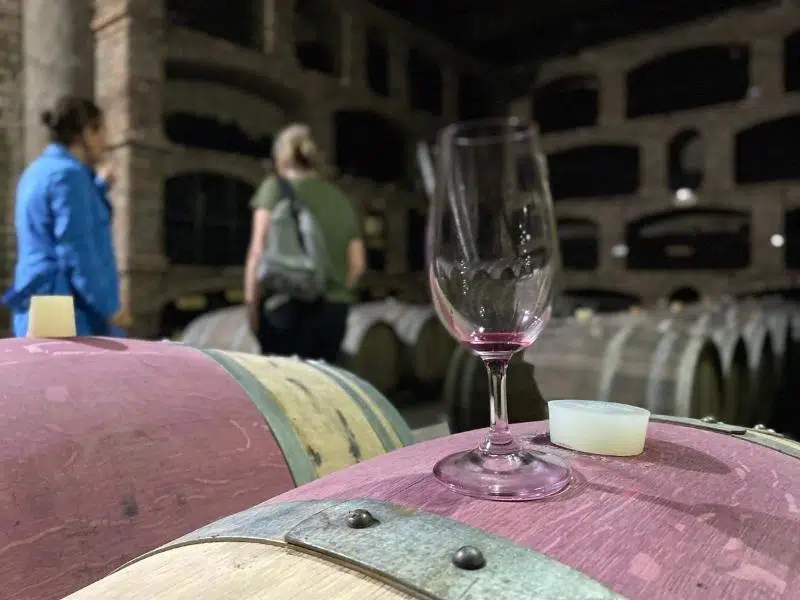
Lagodekhi Protected Areas
At Lagodekhi, you can take a day hike up to the old Machi Castle on the Azerbaijan border, or the Ninoskhevi and Black Grouse waterfalls. If you have longer, take the three-day trek with horses to the spectacular Black Rock Lake on the Dagestan border, but only between the months of June and September.
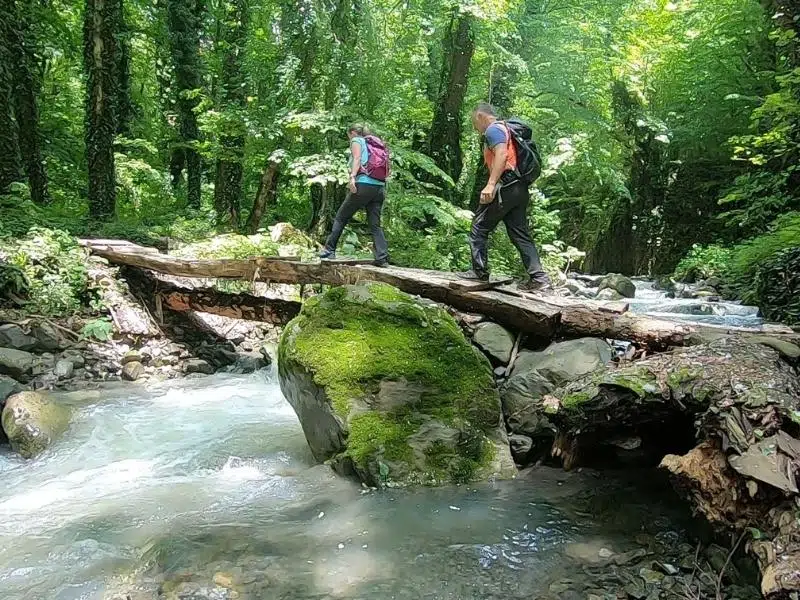
Sighnaghi
Sighnaghi is a pretty town perched on a lofty hilltop, with the most incredible views of the mighty Caucasus and the vast green Alazani valley. With 18th and 19th-century architecture lining the streets, complete and walkable medieval walls and battlements, and a lively tourist scene, it’s well worth stopping for a few days.
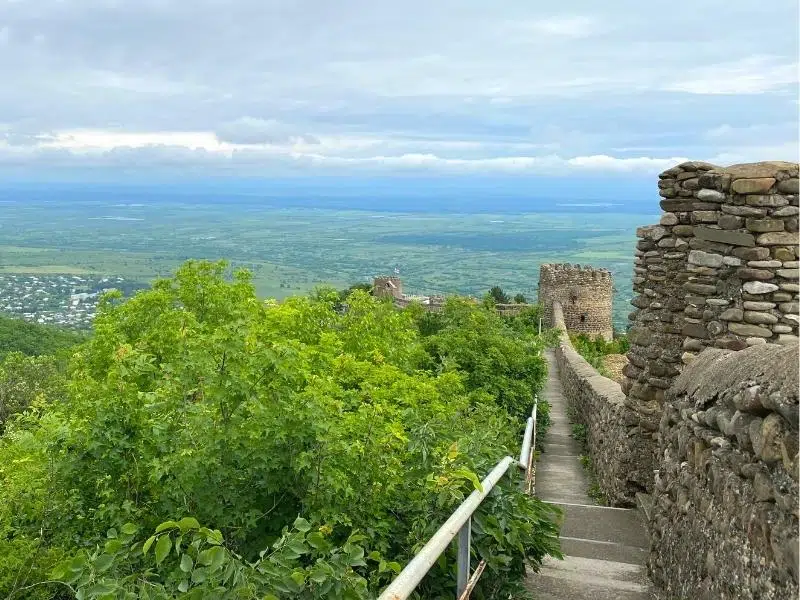
Vashlovani Protected Areas
A fantastic side trip from this Kakheti road trip is the otherworldly Vashlovani Protected Areas, home to many endangered animals and birds, and fascinating desert-like landscapes, savanna, mud volcanoes and barren plateaus.
You need a 4×4 for this trip and a permit to drive into the protected areas, which you can pick up from the visitor centre in Dedoplistskaro.
RELATED POST: SIM Cards in Georgia: How to Buy + Best Deals
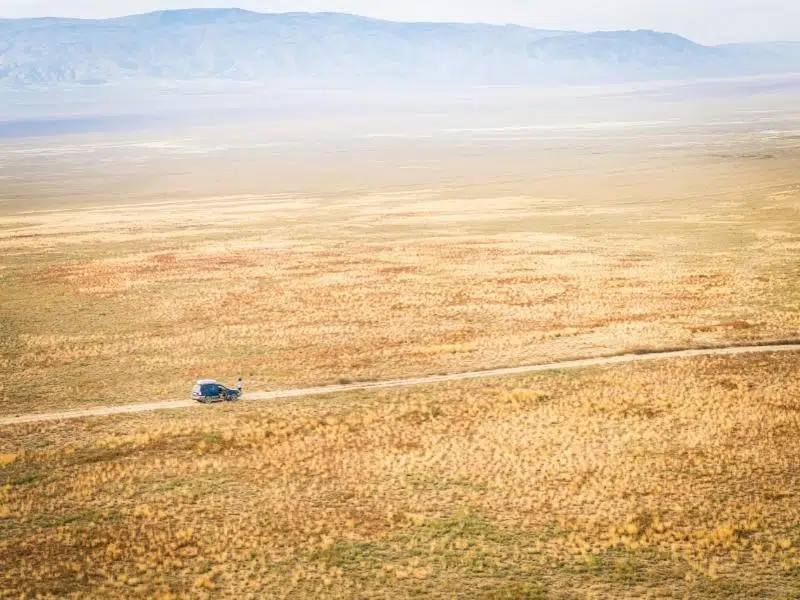
Route & Travel Tips
Do not underestimate the challenge of driving the Tusheti road. Unsealed, prone to rock falls, landslides and disintegration, and narrow in places with sheer drops into distant gorges, this road requires confident and competent driving and can only be done in a four-wheel drive vehicle with good ground clearance. Google Maps suggests this route will take three hours – in reality, you need five to six hours.
The road will be closed from late September to June every year, but check here before starting your trip, as the weather dictates restrictions and the snows can come early or late depending on the year. If there has been heavy rain in the previous days, check before setting off, as this is the worst weather for this unstable and dangerous road, even in summer.
Make sure you have enough fuel on board as there are no gas stations in Tusheti, and carry extra food and water supplies for the journey.
If you decide to road trip Vashlovani, try and do so when the weather is dry in June and July. The landscape here becomes a claggy clay bog when it’s wet, which even the best 4×4 driver will struggle to cope with.
Don’t forget your road trip essentials! Our free road trip checklists help you remember everything, including road trip snacks, podcasts and road trip songs for the journey!
Udabno & Davit Gareja Monastery
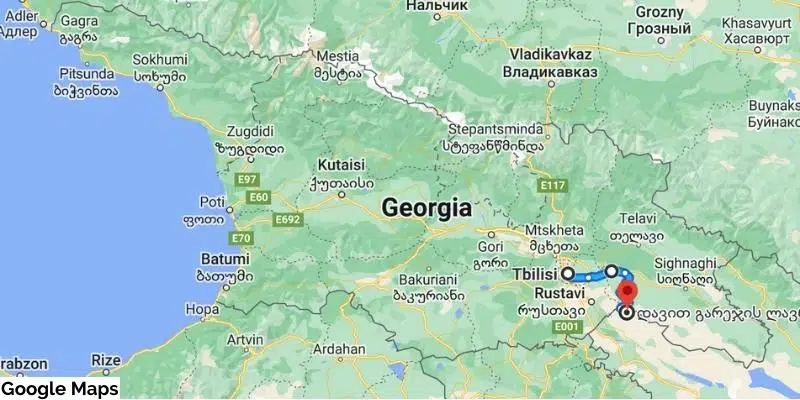
Overview
This is a wonderfully easy drive, and once you leave the S5 main road out of Tbilisi, you’ll be driving through gorgeous rolling pastures. In spring, the whole area is carpeted in wildflowers.
This is not the most adventurous of Georgian road trips, but there is plenty to explore, from the sunflower fields in Sartichala, to the curious Soviet-built Udabno, which is populated by Svaneti eco-migrants. And of course, the stunning monastery complex of Davit Gareja awaits, perched between the Azerbaijan border and the incredible rainbow hills in the valley below.
Highlights
Sartichala Sunflower Fields
Sunflowers are grown in Sartichala to produce sunflower oil, a popular ingredient in Georgian cuisine and an essential dressing for a traditional Georgian salad of tomato, cucumber, red onion and herbs like parsley, purple basil, coriander and dill. The amber-coloured cold-pressed oil has a nutty flavour which enhances those of the salad, to create a match made in heaven.
Visit in July and early August to see the flowers at their peak, and walk amongst the bee-filled fields to take some amazing photographs. You can find the sunflower fields here, but be aware that some years they grow corn instead, which just doesn’t have the same appeal!
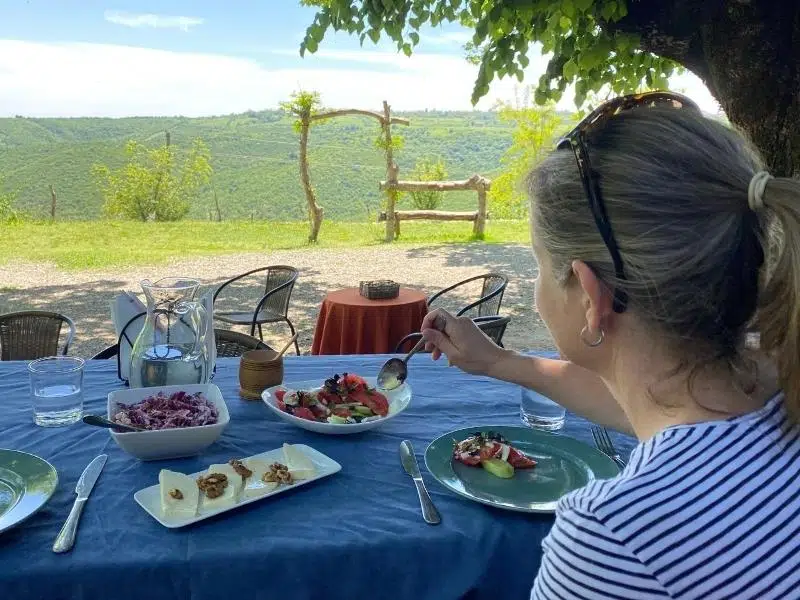
Udabno
Udabno was built in the mid-1980s during the Soviet occupation, as a home for eco-migrants coming from the mountainous Svaneti region. Its remote location is close to the Davit Gareja monastery and the Azerbaijan border, and the feisty character of the Svan people who live there means Udabno is definitely worth exploring.
The town itself feels a little ramshackle, with unpaved roads and domestic animals like cows, pigs and chickens running riot! There are two very basic shops, a couple of hostels with restaurants, and that’s about it. But the surrounding landscape is glorious, with endless rolling pastures where the tectonic plates of Eurasia and Afro-Arabia collide.
Make sure to check out the Oasis Club on your way through, or even book a room if you plan to make this a multi-day road trip. Run by a charming Polish couple, the hostel and eatery is a lively hub on the outskirts of the village and serves a mix of traditional Georgian and Polish food. With hostel rooms, camping and a handful of standalone en-suite cottages, the Oasis Club makes a great base, which we highly recommend.
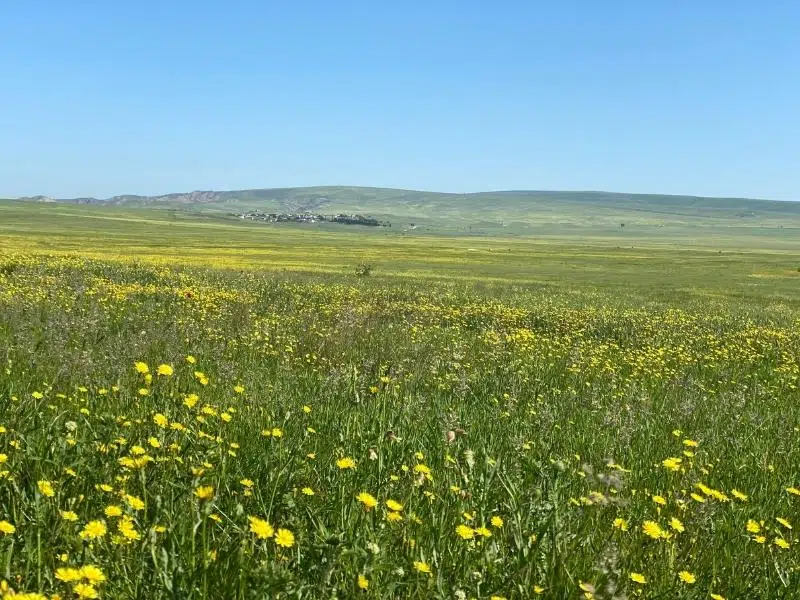
Davit Gareja
Sometimes called David Gareja, this UNESCO rock-hewn Georgian Orthodox cave monastery complex is one of the most important landmarks of Georgia. The complex comprises 19 medieval hermitages constructed during the time of St. David Garejeli, one of the Thirteen Assyrian Fathers who came to Georgia from Mesopotamia in the 6th century to strengthen Christianity in Georgia.
Remarkably, these monks and the ones who came after, carved over 5,000 cells from the rock, including churches, chapels and day-to-day living spaces – enough to house hundreds of people.
With part of the complex straddling the Georgian-Azerbaijani border, it’s not always possible to see some of the monasteries. When we visited in 2022, the Udabno and Chichkhituri monasteries were closed to visitors and have been since 2019. The Bertubani monastery is firmly in Azerbaijan territory.
The name Davit Gareja is generally used to refer to the two most prominent monasteries in the complex, Lavra (also known as St. David’s Monastery) and Udabno. It is still possible to visit St David’s monastery, the most well-preserved of the whole complex. You can wander at will around the caves, chapel and beautiful wooden balconies and soak up the peace and spirituality that’s here in abundance.
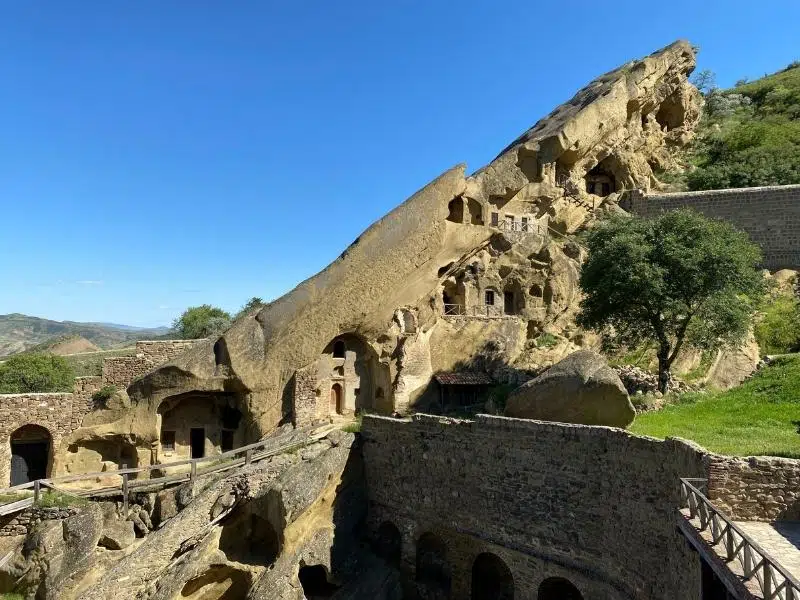
Rainbow Hills
Surrounding the monastery are the huge and dramatic landscapes that Georgia is known for, and in the valley below are undulating rainbow hills, striped with the vibrant pinks, oranges and reds that come from the mineral-rich sedimentary rock.
About 550m before the Davit Gareja Visitor Centre is a track from the north side of the road, which takes you down to the valley of rainbow hills. We spent a few hours hiking in the hills, taking photographs and spotting high-flying raptors and tortoises as they slowly trundled along. We hiked across the hills from the bottom of the track to the grassy plateau in front of Davit Gareja.
It is possible to climb back up to the monastery from here, but the tracks are few and very steep, so you may prefer to do a loop around the colourful hills and go back up the way you came down.
In summer it will be blisteringly hot, and there is absolutely no shade. You’ll need a hat, suncream and lots of water to spend time in the beautiful stripey hills.
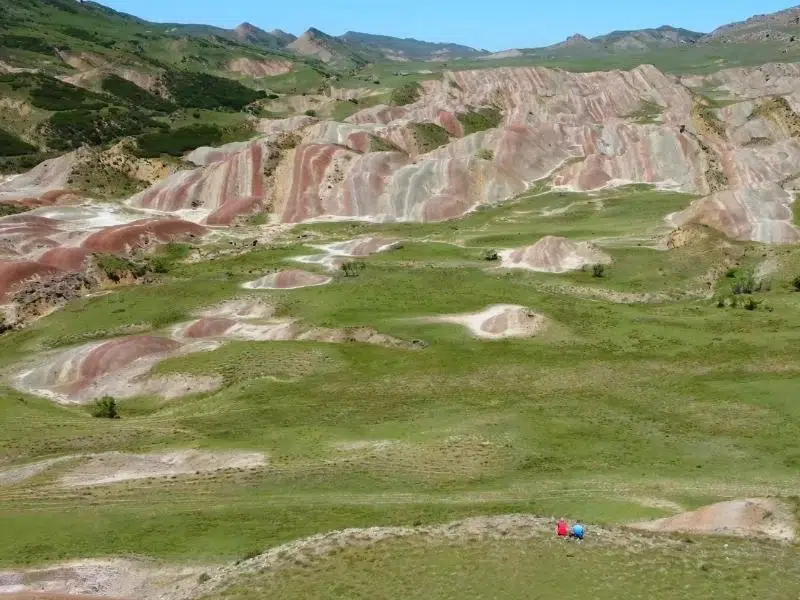
Natlismtsemeli Monastery
Known also as Saint John monastery, Natlismtsemeli monastery is located 12km west of the Davit Gareja plateau. The foundations were laid by Luciane, a student of David Gareja, at the end of the 7th century.
The complex here consists of numerous cave temples and a central church which stands out for its extraordinary height. There is also a smaller church south of the main church, whose fragmented frescos date back to the 12th century. To reach that church it is necessary to climb the rock, so make sure to wear robust shoes with a good grip.
You really need a 4WD vehicle to get to this monastery, although a competent driver could manage the road in a car with robust tires and good ground clearance, on a dry day!
Route & Travel Tips
The road to Udabno and Davit Gareja is a pleasure to drive, well maintained and generally not very busy other than the odd coach party making their pilgrimage to the monastery.
There will be plenty of unfenced livestock around though, who wander into the road without a thought. You’ll also come across herds of cows, goats and sheep, usually with a shepherd and a few dogs to manage their progress. Although it is your right of way, we always felt it courteous to slow down and let them cross in front of us – apart from anything else, we enjoyed the spectacle.
There have been demonstrations at David Gareja in the past few years, as tensions have erupted over who owns what, and a small stretch of Georgian road which actually crosses the Azerbaijan border – look closely on Google Maps and you can spot it for yourself, just east of where the 172 meets the 195. If you can, check locally to make sure the monastery is open and there are no demonstrations planned.
Kutaisi and Around
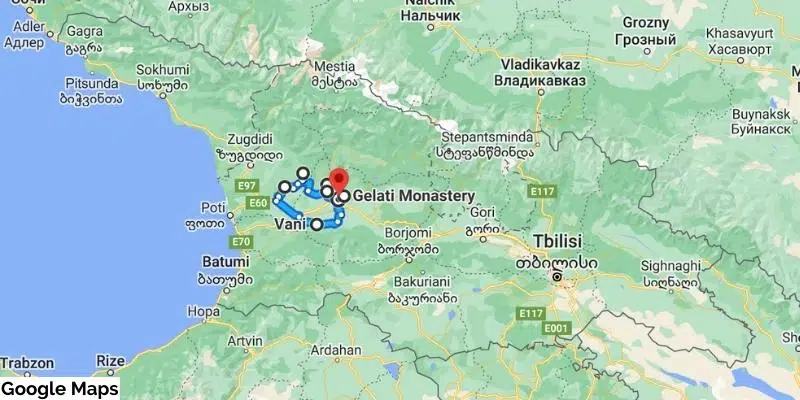
Overview
Kutaisi is one of the oldest continuously inhabited cities in the world, and the city and surrounding area are chock-full of historic monuments, natural wonders and exciting things to do, making it a must-see destination on your Georgia trip.
This Georgia road trip itinerary will take you to hot springs, fortresses, lush canyons and mystical caves, which can be explored on self-drive one day trips from the city, or in a big loop around the countryside.
Highlights
Kutaisi
Once the capital of several historical kingdoms within Georgia, Kutaisi today is one of Georgia’s hidden gems and is often passed by. But, this charming city has a lot to offer and makes a great base for exploring the surrounding area.
In the city itself, the 11th-century Bagrati Cathedral dominates the skyline. In the city centre, the magnificent Colchis fountain takes pride of place, next to a shady park, perfect for a quick rest stop. The Green Bazaar, an extraordinary indoor market, is where locals buy all their groceries and everything else it seems!
Outside the indoor market on Paliashvili Alley is a magnificent terra cotta relief sculpture from the Soviet era. Once you’ve admired that, head south to Tsmindo Nina Street for a coffee and cake at one of the popular cafés along the tree-lined boulevard.
Kutaisi is also the place to sample Georgia’s Imereti cuisine, famous for its vibrant and fresh flavours, and use of vegetables and herbs. Khachapuri, the cheese bread, pkhali, the vegetarian starters full of walnuts and herbs, and the deliciously tart tkemali plum sauce all feature on menus here, alongside the light and fruity Imeretian wine made locally. Lilestan is our pick for Georgian food in Kutaisi, you’ll be spoiled for choice with their innovative menu and delicious flavours.
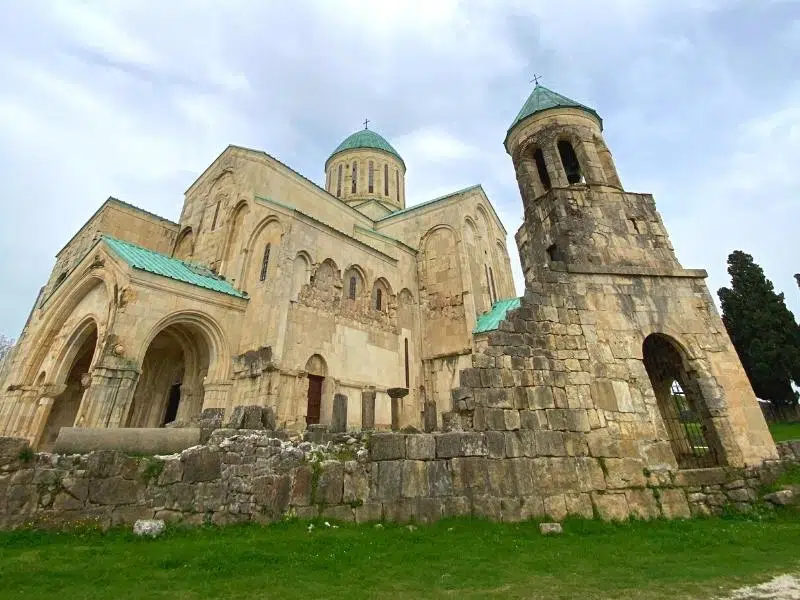
Gelati Monastery
Fifteen minutes north-east of Kutaisi is one of Georgia’s most famous monuments, the UNESCO-listed Gelati Monastery, a masterpiece of the Golden Age of medieval Georgia, a period of political strength and economic growth sandwiched between the reigns of King David IV ‘the Builder’ and Queen Tamar, during the 11th to 13th centuries.
Built by David himself, and thought to be his final resting place, Gelati was not simply a monastery, it was also a centre of science and education, and the Academy established there was one of the most important centres of culture in ancient Georgia. As a royal monastery, Gelati possessed extensive lands and was richly endowed with icons, and at its peak, reflected the power and high culture of Eastern Christianity.
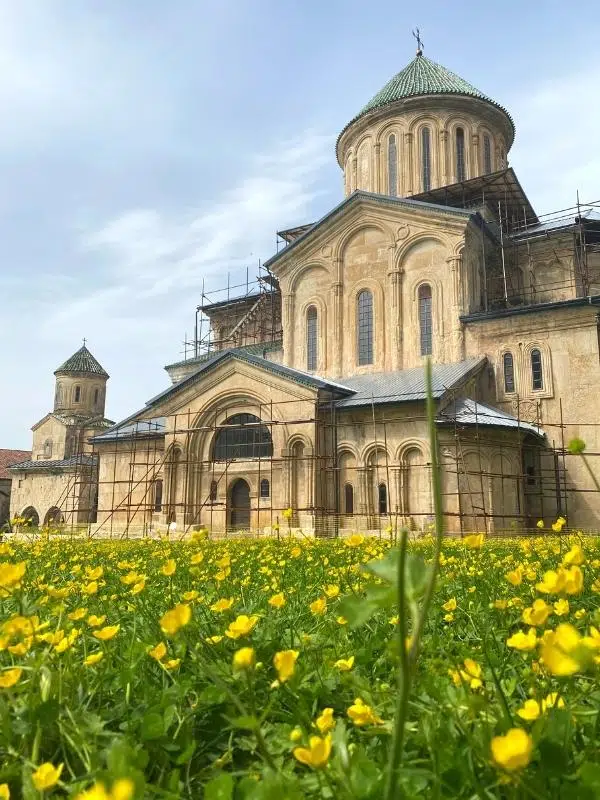
Tskaltubo
This curious town between Kutaisi and the Prometheus cave is well worth a stop as you pass through. Once a decadent Soviet spa town, built to cater for thousands of Russian tourists including Stalin himself, it fell into wrack and ruin when Georgia gained its independence.
Once an elegant Soviet destination that attracted visitors for its natural springs, Tskaltubo is now an array of crumbling hotels, bathhouses and sanitoriums. In the last few years, the town has risen to prominence once again, with photographers, Russophiles and dark tourism bloggers arriving to capture the crumbling architecture.
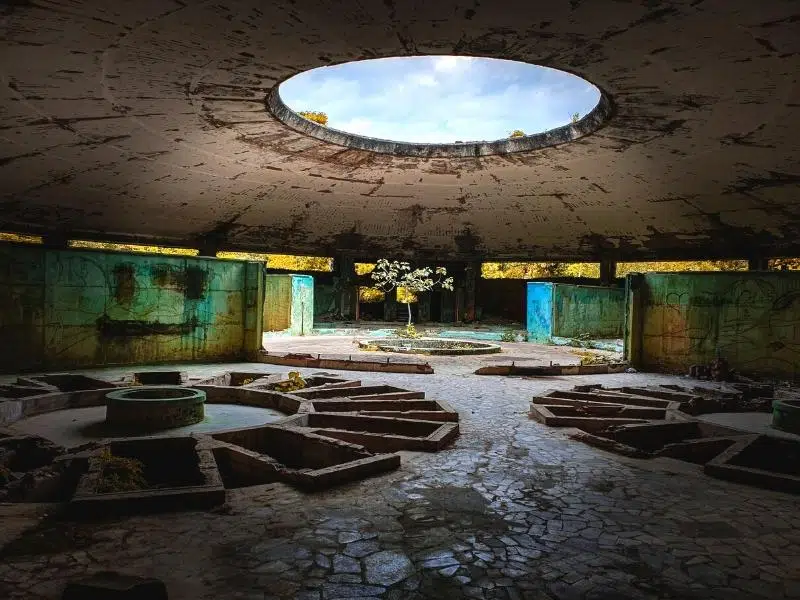
Prometheus Cave
This fantastical cave system north of Kutaisi is formed from karst, where the dissolving of the bedrock has created a huge system of underground chambers complete with their own river. The total length of the cave is about 11km, of which 1060m are open to visitors, including a river system. The cave has a total of 22 halls, six of which are currently open for tourists to visit.
Discovered in 1985, the cave’s development for tourism was halted by the collapse of the Soviet Union. Opened fully in 2011, it is possible to walk through the huge halls and interconnecting tunnels and admire the stalagmites and stalactites, which create weird and wonderful shapes.
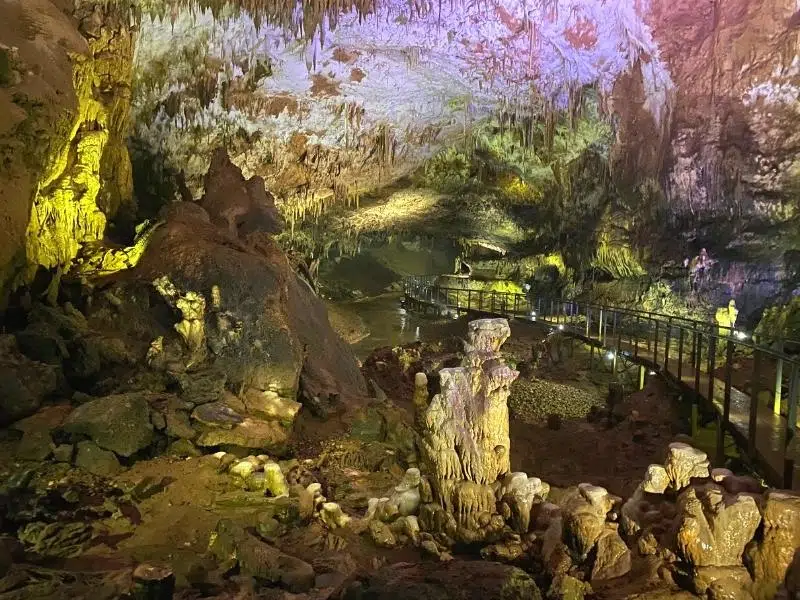
Martvili Canyon
Martvili Canyon is one of the most visited spots in the whole of Georgia, and, along with Prometheus Cave, a top day trip from Kutaisi. That mean’s it gets super busy!
The 2.4km long gorge with dramatic 70m high rock walls has been carved out over millennia by the Abasha river, to create a beautiful landscape replete with waterfalls, turquoise water and lush plants. Man has added a few bridges, a 700m walkway, a zip line and a 20-minute inflatable boat ride, which in no way allow you to fully explore the beauty of the surroundings.
It’s a shame because there are lots of spots close by with access to the river and waterfalls which don’t form part of the ‘touristic’ experience and are free to visit, but these are being overrun by the development of the site. If you prefer a quieter spot with less obvious pressure to sell the experience, try Okatse Canyon instead.
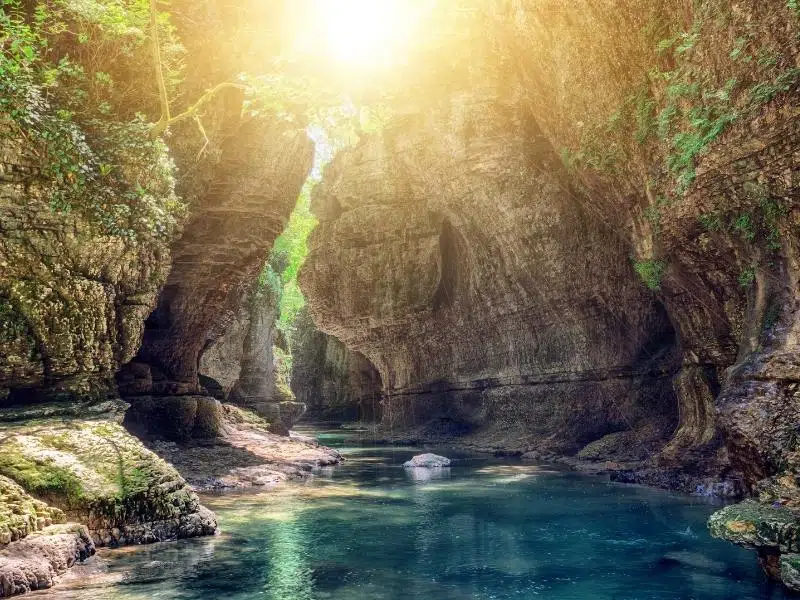
Nokalakevi Fortress
A multi-layered archaeological site, Nokalakevi Fortress at its oldest dates back to the 4th and 5th centuries BCE, although there has been life in this area since the 1st century BCE. Occupying a strategic position on a loop of the Tekhuri River, Nokalakevi was one of the key fortresses guarding the Samegrelo region. This huge 20-hectare site was known to early Byzantine historians as Archaeopolis, and to Georgian chroniclers as Tsikhegoji, the Fortress of Kuji.
Nearby are the Nokalakevi hot springs and a natural swimming pool in the river, worth a visit on a hot day if you have swimmers and a towel with you.
Vani Sulpher Pool
Also known as the Dikhashkho sulfur geyser, this hot Sulpher pool has become an Instagram hit recently. It’s long been known to locals who come to bathe here year-round, but now it’s firmly on the tourist map too.
Close to the historic town of Vani, the springs can be accessed along a very bumpy track, and sit just a hundred metres or so from the wide Rioni river. When you arrive at the pools, they can feel a little underwhelming – often there is rubbish left strewn around from other visitors, and cows trample the nearby sulphury mud, making the whole place feel a bit unkempt.
But, once you sink into the hot water, which spurts out at around 40 degrees, you’ll forget about the surroundings! Lie back, enjoy the gorgeous views of the snowcapped Caucasus mountains and let the warm water work its magic.
There is nothing here other than a changing booth for your modesty. No toilets, no snack van… nothing. Remember to bring towels and water, and if you possibly can, arrive before 9am. Thereafter, it’s a free-for-all until late evening.
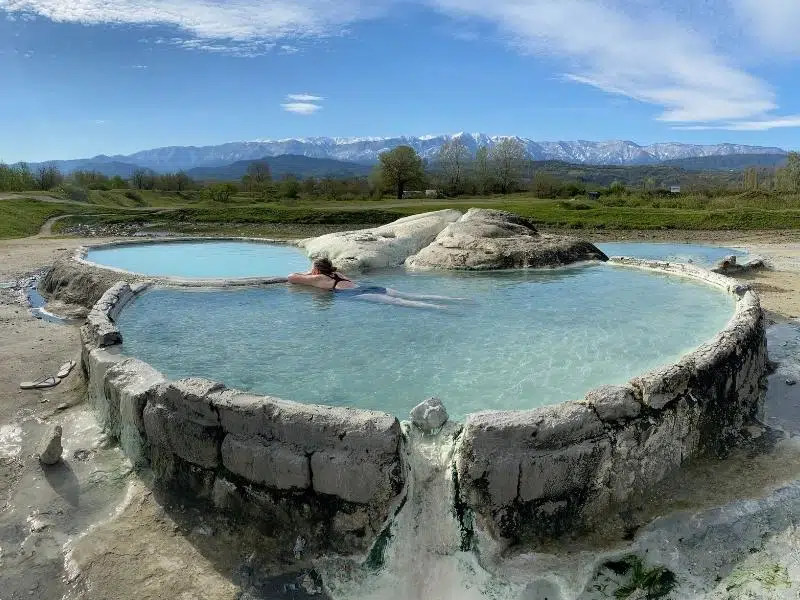
Route & Travel Tips
The area around Kutaisi is popular with visitors and the roads can be busy, particularly in the city. Check out our tips for driving in Georgia so you know what to expect.
Try and get to your destination early in the day to beat the coach trips from Kutaisi and Tbilisi.
Tbilisi to Vardzia
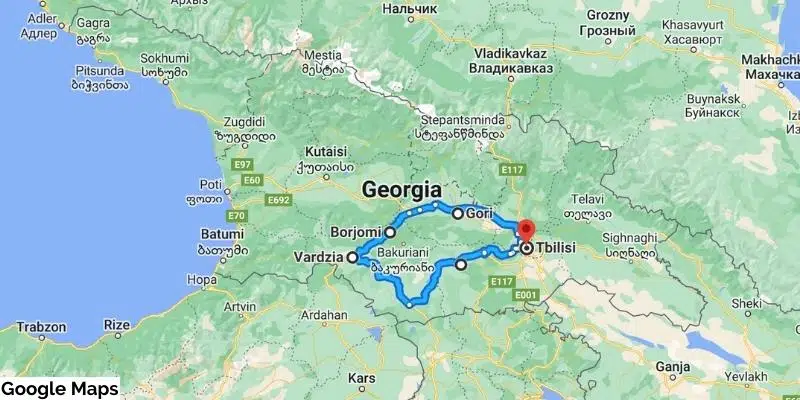
Overview
This road trip in Georgia takes in several of the country’s most iconic sites – Gori, the birthplace of Stalin, and the incredible cave city of Vardzia, as well as a brand new site which only opened in 2022 at the Dashbashi Canyon.
Along the way, you’ll pass through several distinct regions of Georgia, with their own cultures and cuisines to try, several national parks, and some wonderful off-the-beaten-path towns and cities.
Vardzia is also close to both the Turkish and Armenian borders, so this is an ideal road trip if you’re planning on covering a couple of countries.
Highlights
Gori
Gori seems to be a Marmite sort of town – you’ll either love it or hate it. The birthplace of Joseph Stalin sits at the confluence of the Mtkvari and Liakhvi rivers and is the fifth largest city in Georgia.
In medieval times, Gori was an important military stronghold and is home to several notable historic landmarks including the impressive Gori Fortress, which is built on a hill overlooking the central part of the modern city. Across the river stands the 18th-century St. George’s Church of Gorijvari, a popular place of pilgrimage.
Stalin’s association with the city is enshrined in the Joseph Stalin Museum, which is a popular visitor attraction, but there is much more here than just Stalin. Spend some time wandering the pretty old town, visiting the churches and stopping for a coffee along the tree-lined boulevards.
If you do decide to visit the museum, you’ll probably want a guide as there is little information in English, and go with the knowledge that this museum celebrates Stalin and paints a somewhat rosy picture!
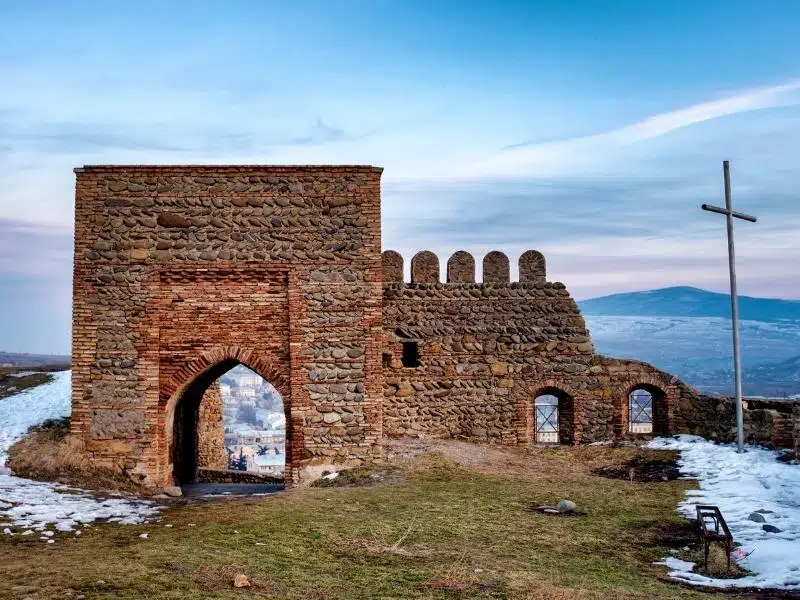
Borjomi
Nestled amongst the densely wooded hills of the Borjomi gorge and famous for its salty and fizzy mineral water, Borjomi is a pretty resort town popular with Georgian and Russian tourists, and hikers visiting Borjomi-Kharagauli National Park. Borjomi was developed as a spa resort in the 19th century by Count Vorontsov, the then Governor of Georgia, apparently, after the army discovered the mineral spring in 1810.
Today the town of Borjomi straddles the Mtkvari river, with the town to the north and the resort on the south bank. Prominent is the Borjomi Central Park, which includes the source of the sulphur mineral spring, wonderful warm thermal baths, tranquil gardens, low-key fairground-type attractions and the Borjomi cable car, which has beautiful views over the town and gorge.
Borjomi is also the starting point for one of Georgia’s most scenic railway journeys on the Kukushka train. This 37km narrow gauge railway connects Borjomi with the mountain resort of Bakuriani and famously crosses the Tsemistskali River on the Eiffel Bridge, built by the Alexandre Gustave Eiffel in 1902. The journey takes around 2.5 hours, with spectacular scenery as your companion the whole way!
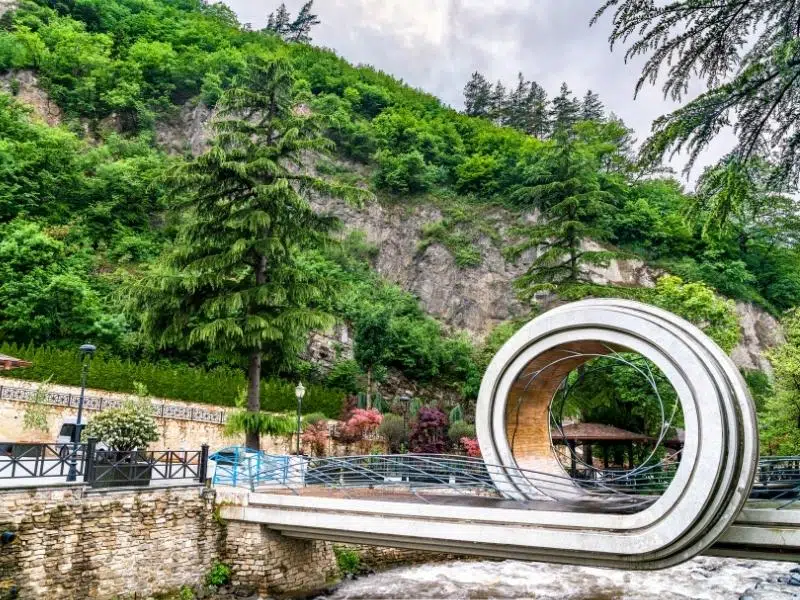
Akhaltsikhe Castle
Located high on a hill overlooking the town, the Rabati castle complex in Akhaltsikhe is a vast medieval fortress built in the 9th century. This huge complex is home to a smaller castle, two churches, an 18th-century palace, a mosque and numerous courtyards, fountains, watch towers and living areas. There is also a modern spa hotel, restaurant, visitor center, open area theater and a history museum.
It’s easy to spend a day here wandering amongst the eclectic architecture, admiring the workmanship of the buildings and learning about the rich history of the complex.
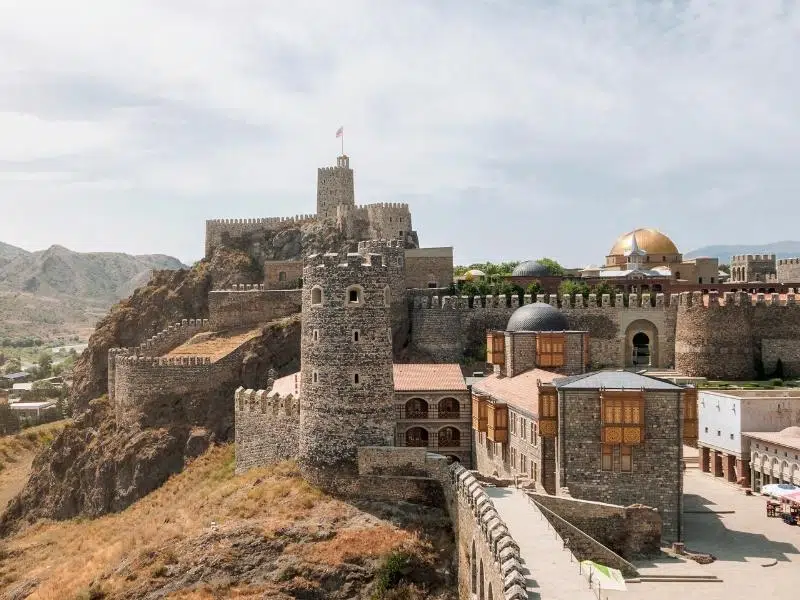
Vardzia
Located deep in the Samtskhe-Javakheti region, the cave city of Vardzia is one of Georgia’s most popular attractions, and rightly so. The sheer scale of what was built here so long ago is breathtaking, and to be able to wander through the caves and see how people lived is fascinating.
Excavated from the sheer rock walls of Erusheti mountain in the second half of the twelfth century, the caves stretch above the picturesque Kura river for an impressive five hundred meters and have thirteen levels. Fed up with being attacked by the Mongols, King Giorgi III saw Vardzia as a place where his people could hide during enemy raids.
The cave city developed and expanded under Queen Tamer, who reigned Georgia between 1184 and 1213 and became a self-sufficient city accommodating up to 50,000 people. With its own church, monastery and nunnery alongside all the spaces a city needs, like storerooms for food, maranis (wine cellars), apothecaries and residential quarters, the city flourished. At its peak, there were nineteen levels and some 6,000 chambers connected by a labyrinthine network of tunnels, stairs and terraces.
Vardzia was abandoned after the Ottoman takeover of Georgia in the 16th century, and today is a state heritage reserve, submitted for inclusion on the UNESCO World Heritage List.
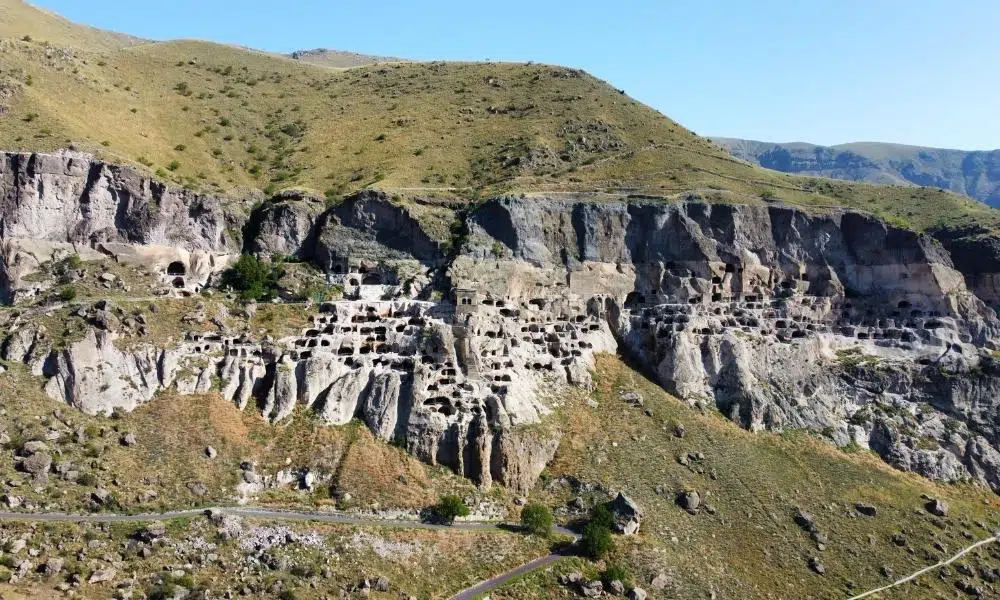
Paravani Lake
As you head back east, be sure to make a quick stop at Poka, on the shores of Lake Paravani at over 2,000m above sea level. A small settlement, Poka St Nino Convent and Poka St Nino Monastery are both worthy of a visit. The nunnery for its amazing handmade European-style Georgian cheese, sweet treats and Georgian handicrafts, and the monastery for the photogenic white slatted wooden church, a few hundred metres from the monastery in a field of wildflowers.
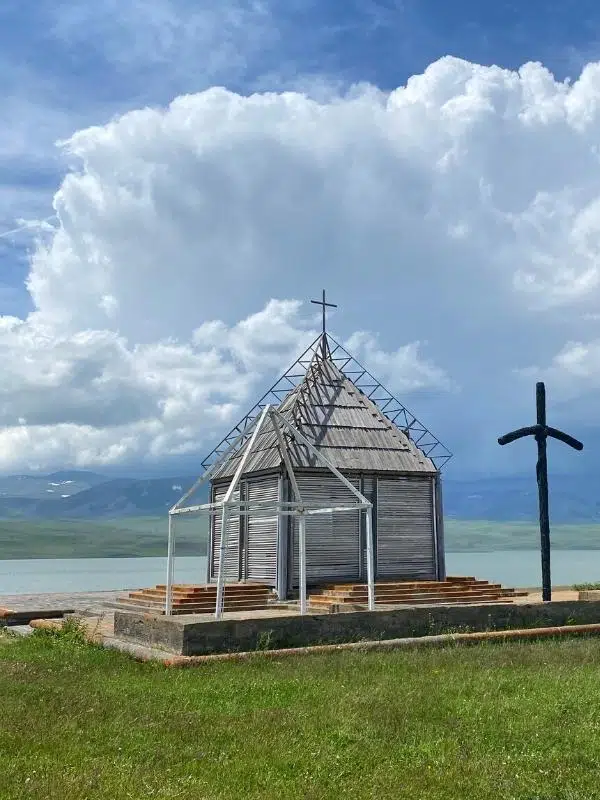
Dashbashi Canyon
Georgia’s newest attraction is the Diamond Bridge, which crosses the spectacular Dashbashi Gorge and the Khrami river at Tsalka. The glass suspension bridge is 240m long and sits 280m high over the gorge, and is eyeing up a Guinness World Record in a bid to be named the world’s largest and tallest free-hanging structure.
You can choose to walk over the bridge and stop at the suspended diamond-shaped glass-floored bar in the middle or cycle over the gorge next to the bridge on a bicycle zipline. We found the whole thing a bit too glitzy (there were fake rocks at the entrance…), and thought the canyon was pretty wow without the addition of the bridge!
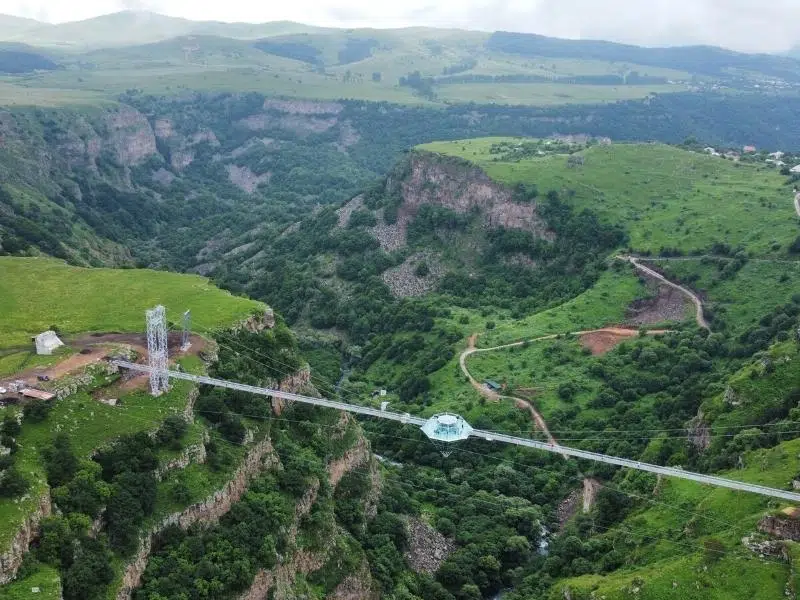
Route & Travel Tips
Just to keep you on your toes, there are two Vardzias in Georgia. Make sure you pick the right one in Google Maps, which is here.
The temperature difference between Vardzia and Lake Paravani can be pretty extreme, and it’s possible to go from too hot to too cold in the space of a few hours. Make sure you’ve got a few layers in the car and be prepared for the mountain road from Poka to Tsalka to be foggy.
Georgia Essentials
Here are the websites and services we personally use and recommend for traveling in Georgia.
Looking for road trip inspiration? Check out these top posts…
Europe Road Trip – 24 Incredible Routes
Norway Road Trip – Three Unmissable Routes
Morocco Road Trip: An Epic Atlantic to Sahara Journey
Adventurous Road Trip – 26 of The World’s Most Exciting Routes
North Coast 500 Route Planner + Itinerary, Map & Tips
The Ultimate Bucket List Italy Road Trip
Love it? Pin it!
